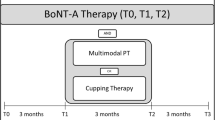Abstract
Patients with cervical dystonia (CD) may present with head and/or neck movements in the coronal, sagittal or transverse plane. According to the Col–Cap concept, CD postures are classified in torti-, latero-, ante- and retrocollis/caput patterns. The frequency of these different subtypes has to be evaluated. Between January and June 2019, we examined 306 patients (55.5 ± 13.1 years, 67% female) with CD according to the Col–Cap concept. They were all treated with botulinum toxin. This prospective study took place in seven different movement disorder centers. The most common primary form was torticaput (49%), the second most common was laterocaput (16.7%). All other subtypes were less than 10% of the study population. Pure forms were observed in 16.3% of patients only. Torticaput was combined in 46% with laterocaput, and in 20.7% with retrocaput. Laterocaput was combined mainly with torticaput (45.1%), laterocollis (33.2%) or retrocaput (23.5%). Shift forms were found in 14.7%, but diagnosed only in 3.9%. On average, the patients had 2.51 (± SD 1.09) subtypes each. Tremor was observed in 55.6%. The mean number of injected muscles was 4.4 (SD 1.6). The most often injected muscles were splenius capitis (83%), sternocleidomatoideus (79.1%), and upper trapezius (58.5%). This is the first multicenter study to examine the frequency of different subtypes of CD according to the Col–Cap concept. The caput subforms are more common than the cervical types, with torticaput as the most common one. Shift forms were diagnosed less often than described. Pure forms are very rare, combinations of 2–6 subtypes are common (83.7%). Sternocleidomatoideus, splenius capitis and trapezius muscles were still injected most often, but the muscles rarely injected in the past such as levator scapulae (48.7%), obliquus capitis inferior (35.3%) and longissimus (16.7%) were considered quite often. Since optimal therapy results depend on the injection of the right muscles, the correct classification should optimize the treatment outcome.

Similar content being viewed by others
References
Camargo CH, Teive HA, Becker N, Baran MH, Scola RH, Werneck LC (2008) Cervical dystonia: clinical and therapeutic features in 85 patients. Arq Neuropsiquiatr 66:15–21
Consky ES, Basinki A, Belle L, Ranawaya R, Lang AE (1990) The Toronto western spasmodic torticollis rating scale (TWSTRS): assessment of validity and inter-rater reliability. Neurology 40(suppl 1):445
Jankovic J, Leder S, Warner D, Schwartz K (1991) Cervical dystonia: clinical findings and associated movement disorders. Neurology 41:1088–1091
Jankovic J, Adler CH, Charles D, Comella C, Stacy M, Schwartz M, Manack Adams A, Brin MF (2015) Primary results from the cervical dystonia patient registry for observation of onabotulinumtoxina efficacy (CD PROBE). J Neurol Sci 349:84–93
Jost WH (2019) Torticaput versus torticollis: clinical effects with modified classification and muscle selection. Tremor Other Hyperkinet Mov. https://doi.org/10.7916/tohm.v0.647
Jost WH, Tatu L (2015) Selection of muscles for botulinum toxin injections in cervical dystonia. Mov Disord Clin Pract 2:224–226
Jost WH, Hefter H, Stenner A, Reichel G (2013) Rating scales for cervical dystonia: a critical evaluation of tools for outcome assessment of botulinum toxin therapy. J Neural Transm 120:487–496
Jost WH, Schramm A, Müngersdorf M, Stenner A, Schwingenschuh P, Maisonobe P, Koch M, Haslinger B (2019) Effectiveness of botulinum neurotoxin type A injections in naïve and previously-treated patients suffering from torti- or laterocollis or -caput: results from a German-Austrian open-label prospective post-marketing surveillance. J Neurol Sci 399:44–50
Reichel G (2011) Cervical dystonia: a new phenomenological classification for botulinumtoxin therapy. Basal Ganglia 1:5–12
Reichel G, Stenner A, Jahn A (2009) The phenomenology of cervical dystonia. Fortschr Neurol Psychiatr 77:272–277
Tatu L, Jost W (2017) Anatomy and cervical dystonia: “dysfunction follows form”. J Neural Transm 124:237–243
Yule GU (1912) On the methods of measuring the association between two variables. The first identification of the phi-coefficient. J R Statist Soc 75:576–642
Acknowledgements
The authors thank Gerhard Reichel (1943–2018), who for the first time systematically summarized the various forms of cervical dystonia, and Tanja Fiesel who organized the dates of the different centers.
Author information
Authors and Affiliations
Contributions
All authors were involved in conception, organization and execution of the research project. WHJ wrote the first draft, all other authors were involved in review and critique. Statistical analysis was done by WHJ with the support of Christian Altmann.
Corresponding author
Ethics declarations
Conflict of interest
Dr. Sanjay Pandey has no conflict of interest. All other authors were speakers and consultants for Allergan, Merz/Desitin and Ipsen, but none relevant to this study (and had no financial or other support)
Ethical standards
For India: Institutional ethics committee, Maulana Azad Medical college and associated hospitals. For Denmark: Local/Danish Ethical Committee and Danish Data Protection Agency (same document). There was no need for ethical approval by a committee in the other countries, in accordance with national law.
Additional information
Publisher's Note
Springer Nature remains neutral with regard to jurisdictional claims in published maps and institutional affiliations.
Rights and permissions
About this article
Cite this article
Jost, W.H., Tatu, L., Pandey, S. et al. Frequency of different subtypes of cervical dystonia: a prospective multicenter study according to Col–Cap concept. J Neural Transm 127, 45–50 (2020). https://doi.org/10.1007/s00702-019-02116-7
Received:
Accepted:
Published:
Issue Date:
DOI: https://doi.org/10.1007/s00702-019-02116-7




